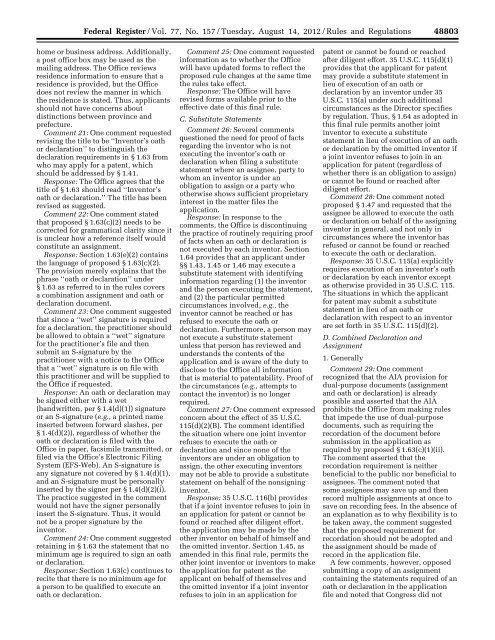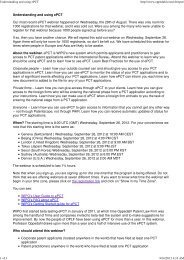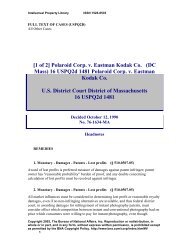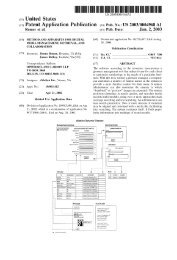48802 Federal Register / Vol. 77, No. 157 / Tuesday, August 14, 2012 / Rules and Regulationssro<strong>be</strong>rts on DSK5SPTVN1PROD with RULESassignment meeting the requirements of35 U.S.C. 115(e) was executed withrespect to the earlier-filed applicationby the individual and was recorded inconnection with the earlier-filedapplication. Thus, an additionalinventor’s oath or declaration would <strong>be</strong>necessary in a continuing applicationonly for an inventor for whom an oathor declaration was not submitted in theprior-filed application. Section 1.63(d),as adopted in this final rule, does notinclude the proposed requirement thatthe statements in the copy of theinventor’s oath or declaration from aprior-filed application also <strong>be</strong>applicable to the continuingapplication.5. Supplemental Oath or DeclarationComment 16: One comment assertedthat once a one-time statement from aninventor has <strong>be</strong>en made in satisfactionof 35 U.S.C. 115, 35 U.S.C. 115(h)(2)precludes the Office from requiring anysupplemental oath or declaration.Several comments objected to proposed§ 1.67 and asserted that the Office wasproposing to merely retain requirementsfor supplemental oaths, notwithstandingthe statutory prohibition against them.Response: Section 1.67(c) providesthat the Office will not require a personwho has executed an oath or declarationin compliance with 35 U.S.C. 115 and§ 1.63 or § 1.162 to provide anadditional oath or declaration. 35 U.S.C.115(h)(2) precludes the Office fromrequiring a supplemental oath ordeclaration only if the initial oath ordeclaration complied with 35 U.S.C. 115and § 1.63 or § 1.162.Comment 17: One comment expressedconcern about the elimination ofsupplemental oaths (proposed § 1.67(b)),as they give the inventor theopportunity to object to the assignee’sinterpretation of the invention whichmay <strong>be</strong> broader than the inventor’sunderstanding of the description. Thecomment noted the existing requirementthat reissue oaths or declarations <strong>be</strong>signed by the inventors when one ormore claims are <strong>be</strong>ing broadened, andsuggested that inventors <strong>be</strong> permitted torequest ‘‘post grant review’’ to clarifynew matter issues that may arise fromdifferences in interpretation.Response: 35 U.S.C. 115(h)(1) and§ 1.67 provide that an applicant maysubmit an inventor’s oath or declarationto correct any deficiencies orinaccuracies present in an earlier-filedinventor’s oath or declaration. 35 U.S.C.115(h)(2) provides that supplementalstatements are not required where theoath or declaration meets 35 U.S.C.115(a) or the assignment meets therequirements of 35 U.S.C. 115(e).Inventors still must execute an oath ordeclaration except under the permittedcircumstances. Thus, inventors wouldstill have an opportunity to review theapplication in connection with theexecution of the oath or declaration andraise any concerns regarding breadth ofthe claimed invention with the assignee.Moreover, an inventor may have accessto the application file and can followthe prosecution. 35 U.S.C. 321(a)provides that a person who is not theowner may request post grant review ofa patent.6. Effective DateComment 18: One commentquestioned whether the Office wouldaccept oaths or declarations (1) In anapplication filed prior to Septem<strong>be</strong>r 16,2012, in which the oath or declarationis filed on or after Septem<strong>be</strong>r 16, 2012;and (2) in an application filed on orafter Septem<strong>be</strong>r 16, 2012, where theoath or declaration was executed priorto Septem<strong>be</strong>r 16, 2012. One commentsuggested that the Office clarify § 1.63 toaddress applications that bridge theeffective date of the rule to make clearthat a new declaration will not <strong>be</strong>required in a continuing applicationwhere the prior declaration wascompliant with the new requiredstatutory statements. A few commentsrecommended that oaths or declarationsfiled <strong>be</strong>fore Septem<strong>be</strong>r 16, 2012, <strong>be</strong>grandfathered in and accepted incontinuing applications filed on or afterSeptem<strong>be</strong>r 16, 2012, even though theoaths or declarations contain thelanguage in former 35 U.S.C. 115 andnot the language in new 35 U.S.C.115(b).Response: The changes to 35 U.S.C.115 in the AIA apply to any applicationfiled on or after Septem<strong>be</strong>r 16, 2012.Accordingly, the date of execution ofthe oath or declaration is not relevant,particularly as the Office does not checksuch dates of execution. MPEP § 602.05.For applications filed prior toSeptem<strong>be</strong>r 16, 2012, any oath ordeclaration filed <strong>be</strong>fore, on, or afterSeptem<strong>be</strong>r 16, 2012, must comply withthe oath and declaration rules in effectprior to Septem<strong>be</strong>r 16, 2012. Any oathor declaration submitted in anapplication filed on or after Septem<strong>be</strong>r16, 2012, (regardless of the date ofexecution of the oath or declaration)must meet the requirements of 35 U.S.C.115 as amended by the AIA.With respect to continuingapplications, 35 U.S.C. 115(g)(1)(A)provides an exception to a newlyexecuted oath or declaration only wherethe oath or declaration in the earlierfiledapplication meets the requirementsof amended 35 U.S.C. 115(a) whichVerDate Mar2010 17:28 Aug 13, 2012 Jkt 226001 PO 00000 Frm 00028 Fmt 4701 Sfmt 4700 E:\FR\FM\14AUR6.SGM 14AUR6must include the required statements in35 U.S.C. 115(b). Accordingly, a copy ofan oath or declaration from a priorapplication filed <strong>be</strong>fore Septem<strong>be</strong>r 16,2012, must meet the requirements of 35U.S.C. 115 as amended by the AIA.Nevertheless, in view of the changesto permit applicants to postpone thesubmission of the inventor’s oath ordeclaration until the application isotherwise in condition for allowance,the Office will no longer review an oathor declaration in an application under35 U.S.C. 111(a) for compliance with§ 1.63 (or a substitute statement forcompliance with § 1.64) during theexamination process. The Office willreview applications to determinewhether the application includes anoath or declaration executed by or withrespect to each inventor when theapplication is in condition forallowance.7. MiscellaneousComment 19: One comment notedthat 35 U.S.C. 115 requires ‘‘the name ofthe inventor,’’ whereas proposed§ 1.63(a)(2) requires identification by‘‘his or her full name without anyabbreviation (except for a middleinitial)’’ and thus places furtherrestrictions on what would otherwise <strong>be</strong>an uncomplicated requirement. Anothercomment stated that the rules shouldpermit an inventor to abbreviate his orher first name if he or she is known byhis or her middle name.Response: The Office agrees that thephrase ‘‘his or her full name withoutany abbreviation (except for a middleinitial)’’ is more complicated thannecessary. The requirement foridentification of the name of theinventor in the rules of practice (e.g.,§ 1.63(a)(1)) will <strong>be</strong> for the legal name ofthe inventor.Comment 20: One comment suggestedeliminating the requirement for theresidence in that: (1) It is still unclearwhat is intended by residence (e.g., city,state, province, prefecture, etc.); (2)many inventors would prefer to keeptheir residence private, especially wherethe mailing address is the place ofemployment; and (3) it requiresassignees to violate their domesticprivacy laws in some countries (e.g.,United Kingdom) by requiring inventorsto make residence information publiclyavailable.Response: The comment appears toconfuse the separate requirements forresidence and mailing address. Theresidence, as noted in MPEP § 605.02, isa city and either a state or foreigncountry, while a mailing address, asnoted in MPEP § 605.03, is where onecustomarily receives mail, such as one’s
Federal Register / Vol. 77, No. 157 / Tuesday, August 14, 2012 / Rules and Regulations48803sro<strong>be</strong>rts on DSK5SPTVN1PROD with RULEShome or business address. Additionally,a post office box may <strong>be</strong> used as themailing address. The Office reviewsresidence information to ensure that aresidence is provided, but the Officedoes not review the manner in whichthe residence is stated. Thus, applicantsshould not have concerns aboutdistinctions <strong>be</strong>tween province andprefecture.Comment 21: One comment requestedrevising the title to <strong>be</strong> ‘‘Inventor’s oathor declaration’’ to distinguish thedeclaration requirements in § 1.63 fromwho may apply for a patent, whichshould <strong>be</strong> addressed by § 1.41.Response: The Office agrees that thetitle of § 1.63 should read ‘‘Inventor’soath or declaration.’’ The title has <strong>be</strong>enrevised as suggested.Comment 22: One comment statedthat proposed § 1.63(c)(2) needs to <strong>be</strong>corrected for grammatical clarity since itis unclear how a reference itself wouldconstitute an assignment.Response: Section 1.63(e)(2) containsthe language of proposed § 1.63(c)(2).The provision merely explains that thephrase ‘‘oath or declaration’’ under§ 1.63 as referred to in the rules coversa combination assignment and oath ordeclaration document.Comment 23: One comment suggestedthat since a ‘‘wet’’ signature is requiredfor a declaration, the practitioner should<strong>be</strong> allowed to obtain a ‘‘wet’’ signaturefor the practitioner’s file and thensubmit an S-signature by thepractitioner with a notice to the Officethat a ‘‘wet’’ signature is on file withthis practitioner and will <strong>be</strong> supplied tothe Office if requested.Response: An oath or declaration may<strong>be</strong> signed either with a wet(handwritten, per § 1.4(d)(1)) signatureor an S-signature (e.g., a printed nameinserted <strong>be</strong>tween forward slashes, per§ 1.4(d)(2)), regardless of whether theoath or declaration is filed with theOffice in paper, facsimile transmitted, orfiled via the Office’s Electronic FilingSystem (EFS-Web). An S-signature isany signature not covered by § 1.4(d)(1),and an S-signature must <strong>be</strong> personallyinserted by the signer per § 1.4(d)(2)(i).The practice suggested in the commentwould not have the signer personallyinsert the S-signature. Thus, it wouldnot <strong>be</strong> a proper signature by theinventor.Comment 24: One comment suggestedretaining in § 1.63 the statement that nominimum age is required to sign an oathor declaration.Response: Section 1.63(c) continues torecite that there is no minimum age fora person to <strong>be</strong> qualified to execute anoath or declaration.Comment 25: One comment requestedinformation as to whether the Officewill have updated forms to reflect theproposed rule changes at the same timethe rules take effect.Response: The Office will haverevised forms available prior to theeffective date of this final rule.C. Substitute StatementsComment 26: Several commentsquestioned the need for proof of factsregarding the inventor who is notexecuting the inventor’s oath ordeclaration when filing a substitutestatement where an assignee, party towhom an inventor is under anobligation to assign or a party whootherwise shows sufficient proprietaryinterest in the matter files theapplication.Response: In response to thecomments, the Office is discontinuingthe practice of routinely requiring proofof facts when an oath or declaration isnot executed by each inventor. Section1.64 provides that an applicant under§§ 1.43, 1.45 or 1.46 may execute asubstitute statement with identifyinginformation regarding (1) the inventorand the person executing the statement,and (2) the particular permittedcircumstances involved, e.g., theinventor cannot <strong>be</strong> reached or hasrefused to execute the oath ordeclaration. Furthermore, a person maynot execute a substitute statementunless that person has reviewed andunderstands the contents of theapplication and is aware of the duty todisclose to the Office all informationthat is material to patentability. Proof ofthe circumstances (e.g., attempts tocontact the inventor) is no longerrequired.Comment 27: One comment expressedconcern about the effect of 35 U.S.C.115(d)(2)(B). The comment identifiedthe situation where one joint inventorrefuses to execute the oath ordeclaration and since none of theinventors are under an obligation toassign, the other executing inventorsmay not <strong>be</strong> able to provide a substitutestatement on <strong>be</strong>half of the nonsigninginventor.Response: 35 U.S.C. 116(b) providesthat if a joint inventor refuses to join inan application for patent or cannot <strong>be</strong>found or reached after diligent effort,the application may <strong>be</strong> made by theother inventor on <strong>be</strong>half of himself andthe omitted inventor. Section 1.45, asamended in this final rule, permits theother joint inventor or inventors to makethe application for patent as theapplicant on <strong>be</strong>half of themselves andthe omitted inventor if a joint inventorrefuses to join in an application forVerDate Mar2010 17:28 Aug 13, 2012 Jkt 226001 PO 00000 Frm 00029 Fmt 4701 Sfmt 4700 E:\FR\FM\14AUR6.SGM 14AUR6patent or cannot <strong>be</strong> found or reachedafter diligent effort. 35 U.S.C. 115(d)(1)provides that the applicant for patentmay provide a substitute statement inlieu of execution of an oath ordeclaration by an inventor under 35U.S.C. 115(a) under such additionalcircumstances as the Director specifiesby regulation. Thus, § 1.64 as adopted inthis final rule permits another jointinventor to execute a substitutestatement in lieu of execution of an oathor declaration by the omitted inventor ifa joint inventor refuses to join in anapplication for patent (regardless ofwhether there is an obligation to assign)or cannot <strong>be</strong> found or reached afterdiligent effort.Comment 28: One comment notedproposed § 1.47 and requested that theassignee <strong>be</strong> allowed to execute the oathor declaration on <strong>be</strong>half of the assigninginventor in general, and not only incircumstances where the inventor hasrefused or cannot <strong>be</strong> found or reachedto execute the oath or declaration.Response: 35 U.S.C. 115(a) explicitlyrequires execution of an inventor’s oathor declaration by each inventor exceptas otherwise provided in 35 U.S.C. 115.The situations in which the applicantfor patent may submit a substitutestatement in lieu of an oath ordeclaration with respect to an inventorare set forth in 35 U.S.C. 115(d)(2).D. Combined Declaration andAssignment1. GenerallyComment 29: One commentrecognized that the AIA provision fordual-purpose documents (assignmentand oath or declaration) is alreadypossible and asserted that the AIAprohibits the Office from making rulesthat impede the use of dual-purposedocuments, such as requiring therecordation of the document <strong>be</strong>foresubmission in the application asrequired by proposed § 1.63(c)(1)(ii).The comment asserted that therecordation requirement is neither<strong>be</strong>neficial to the public nor <strong>be</strong>neficial toassignees. The comment noted thatsome assignees may save up and thenrecord multiple assignments at once tosave on recording fees. In the absence ofan explanation as to why flexibility is to<strong>be</strong> taken away, the comment suggestedthat the proposed requirement forrecordation should not <strong>be</strong> adopted andthe assignment should <strong>be</strong> made ofrecord in the application file.A few comments, however, opposedsubmitting a copy of an assignmentcontaining the statements required of anoath or declaration in the applicationfile and noted that Congress did not
- Page 1:
UNIFORM CERTIFICATE OF ATTENDANCE F
- Page 4 and 5:
SPTO explains the America Invents A
- Page 6 and 7:
PTO/SB/01A (01-09)Approved for use
- Page 8 and 9:
PTO/SB/ (06-12)Approved for use thr
- Page 10 and 11:
PTO/ (06-12)Approved for use throug
- Page 12 and 13:
PTO/(06-1Approved for use through 0
- Page 14 and 15:
What will change about the oath ord
- Page 16 and 17:
Action item●●●If you have not
- Page 18 and 19:
But 37 CFR § 1.63 says:A person ma
- Page 20 and 21:
●●●Combined assignment anddec
- Page 22 and 23:
●●●●●●Consequences of i
- Page 24 and 25:
How to file the ADSs●●If you pr
- Page 26 and 27:
Supplemental ADSAny ADS filed after
- Page 28 and 29: Provisionals●●●Rules are a bi
- Page 30 and 31: Are all assignees applicants?●●
- Page 32 and 33: Substitute Statement●●●This f
- Page 34 and 35: ●●●Docket consequences of the
- Page 36 and 37: New Rule-46 practice67●●●Rule
- Page 38 and 39: Consequences of AIA for PCT filers
- Page 40 and 41: If you are entrusted the US nationa
- Page 42 and 43: ●●●Choosing between a “bypa
- Page 44 and 45: ●●●Getting your name and addr
- Page 46 and 47: Exercises relating to September 16,
- Page 48 and 49: Important AIA webinar September 6
- Page 50 and 51: Exercises relating to September 16,
- Page 52 and 53: 48776 Federal Register / Vol. 77, N
- Page 54 and 55: sroberts on DSK5SPTVN1PROD with RUL
- Page 56 and 57: sroberts on DSK5SPTVN1PROD with RUL
- Page 58 and 59: sroberts on DSK5SPTVN1PROD with RUL
- Page 60 and 61: sroberts on DSK5SPTVN1PROD with RUL
- Page 62 and 63: sroberts on DSK5SPTVN1PROD with RUL
- Page 64 and 65: sroberts on DSK5SPTVN1PROD with RUL
- Page 66 and 67: sroberts on DSK5SPTVN1PROD with RUL
- Page 68 and 69: sroberts on DSK5SPTVN1PROD with RUL
- Page 70 and 71: sroberts on DSK5SPTVN1PROD with RUL
- Page 72 and 73: sroberts on DSK5SPTVN1PROD with RUL
- Page 74 and 75: 48798 Federal Register / Vol. 77, N
- Page 76 and 77: 48800 Federal Register / Vol. 77, N
- Page 80 and 81: 48804 Federal Register / Vol. 77, N
- Page 82 and 83: 48806 Federal Register / Vol. 77, N
- Page 84 and 85: 48808 Federal Register / Vol. 77, N
- Page 86 and 87: 48810 Federal Register / Vol. 77, N
- Page 88 and 89: 48812 Federal Register / Vol. 77, N
- Page 90 and 91: 48814 Federal Register / Vol. 77, N
- Page 92 and 93: 48816 Federal Register / Vol. 77, N
- Page 94 and 95: sroberts on DSK5SPTVN1PROD with RUL
- Page 96 and 97: sroberts on DSK5SPTVN1PROD with RUL
- Page 98 and 99: 48822 Federal Register / Vol. 77, N
- Page 100 and 101: sroberts on DSK5SPTVN1PROD with RUL
- Page 102: 48826 Federal Register / Vol. 77, N





